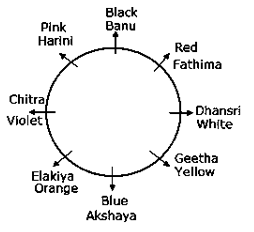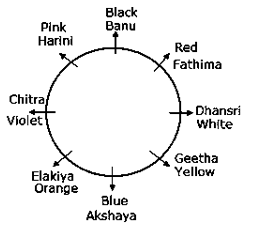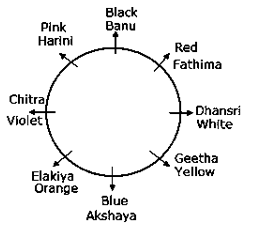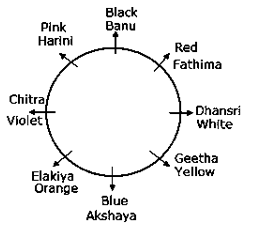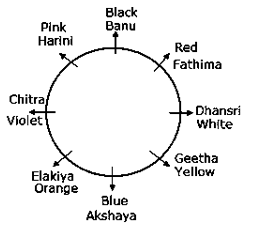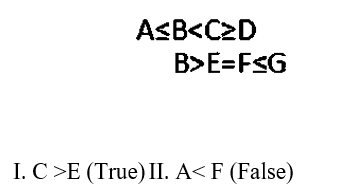Question 1:
Direction: Study the following information carefully and answer the questions given below:
निर्देश: नीचे दी गई जानकारी को ध्यान से पढ़ें और निम्नलिखित प्रश्नों का उत्तर दें।
Eight Persons Akshaya, Banu, Chitra, Dhansri, Elakiya, Fathima, Geetha, and Harini are sitting around a circular table but not facing inside. Each one of them like’s different colours i.e. Black, Pink, Yellow, Orange, Pink, Red, Violet, and White but not necessarily in the same order.
The one who likes Blue sits third to the right of Fathima. Neither Banu nor Geetha likes Blue. Banu likes Black, who sits third to the left of Geetha. The one who likes white sits third to the right of Harini. Only one person sits between the one who likes blue and Dhansri. Chitra likes violet, sits second to the right of Akshaya, who is not neighbour osf Banu. The one who likes Black sits third to the left of the one who likes Yellow. Neither Akshaya nor Banu likes White. The one who likes Orange is not an immediate neighbour of the one who likes Black. Harini does not like Red. Elakiya does not like Blue. Geetha does not sit immediate right of the one who likes Blue.
आठ व्यक्ति अक्षय, बनू, चित्र, धनसरी, इलाकी, फातिमा, गीता और हरिनी एक वृताकार टेबल के चारों ओर बैठे हैं लेकिन अंदर का सामना नहीं कर रहे हैं। उनमें से प्रत्येक को अलग-अलग रंग जैसे काला, गुलाबी, पीला, नारंगी, गुलाबी, लाल, बैंगनी, और सफेद पसंद है लेकिन एक ही क्रम में जरूरी नहीं है।
जो नीला पसंद करता है वह फातिमा के दाहिने ओर तीसरे स्थान पर है। न तो बनू और न ही गीता नीला पसंद करते हैं। बनू काला पसंद करता हैं, जो गीता के बाईं ओर तीसरे स्थान पर हैं। जो सफेद पसंद करता है वह हरिनी के दाहिने ओर तीसरे स्थान पर है। केवल एक व्यक्ति नीला पसंद करने वाले व्यक्ति और धनसरी के बीच बैठता है। चित्र बैंगनी पसंद करता है, और अक्षय के दाहिने ओर दूसरे स्थान पर बैठता है, जो बनू के पड़ोसी नहीं है। जो काला पसंद करता है वह पीले को पसंद करने वाले व्यक्ति के बाईं ओर तीसरे स्थान पर बैठता है। न तो अक्षय और न ही बनू को सफेद पसंद है। जो नारंगी पसंद करता है वह काला पसंद करने वाले व्यक्ति का तत्काल पड़ोसी नहीं है। हरिनी को लाल पसंद नहीं है। इलाकी को नीला पसंद नहीं है। गीता नीला पसंद करने वाले व्यक्ति के तत्काल दाएं नहीं बैठती है।
Who sits third to the right of Dhansri?
धनसरी के दाहिनी ओर तीसरे स्थान पर कौन है?
Question 2:
Direction: Study the following information carefully and answer the questions given below:
निर्देश: नीचे दी गई जानकारी को ध्यान से पढ़ें और निम्नलिखित प्रश्नों का उत्तर दें।
Eight Persons Akshaya, Banu, Chitra, Dhansri, Elakiya, Fathima, Geetha, and Harini are sitting around a circular table but not facing inside. Each one of them like’s different colours i.e. Black, Pink, Yellow, Orange, Pink, Red, Violet, and White but not necessarily in the same order.
The one who likes Blue sits third to the right of Fathima. Neither Banu nor Geetha likes Blue. Banu likes Black, who sits third to the left of Geetha. The one who likes white sits third to the right of Harini. Only one person sits between the one who likes blue and Dhansri. Chitra likes violet, sits second to the right of Akshaya, who is not neighbour osf Banu. The one who likes Black sits third to the left of the one who likes Yellow. Neither Akshaya nor Banu likes White. The one who likes Orange is not an immediate neighbour of the one who likes Black. Harini does not like Red. Elakiya does not like Blue. Geetha does not sit immediate right of the one who likes Blue.
आठ व्यक्ति अक्षय, बनू, चित्र, धनसरी, इलाकी, फातिमा, गीता और हरिनी एक वृताकार टेबल के चारों ओर बैठे हैं लेकिन अंदर का सामना नहीं कर रहे हैं। उनमें से प्रत्येक को अलग-अलग रंग जैसे काला, गुलाबी, पीला, नारंगी, गुलाबी, लाल, बैंगनी, और सफेद पसंद है लेकिन एक ही क्रम में जरूरी नहीं है।
जो नीला पसंद करता है वह फातिमा के दाहिने ओर तीसरे स्थान पर है। न तो बनू और न ही गीता नीला पसंद करते हैं। बनू काला पसंद करता हैं, जो गीता के बाईं ओर तीसरे स्थान पर हैं। जो सफेद पसंद करता है वह हरिनी के दाहिने ओर तीसरे स्थान पर है। केवल एक व्यक्ति नीला पसंद करने वाले व्यक्ति और धनसरी के बीच बैठता है। चित्र बैंगनी पसंद करता है, और अक्षय के दाहिने ओर दूसरे स्थान पर बैठता है, जो बनू के पड़ोसी नहीं है। जो काला पसंद करता है वह पीले को पसंद करने वाले व्यक्ति के बाईं ओर तीसरे स्थान पर बैठता है। न तो अक्षय और न ही बनू को सफेद पसंद है। जो नारंगी पसंद करता है वह काला पसंद करने वाले व्यक्ति का तत्काल पड़ोसी नहीं है। हरिनी को लाल पसंद नहीं है। इलाकी को नीला पसंद नहीं है। गीता नीला पसंद करने वाले व्यक्ति के तत्काल दाएं नहीं बैठती है।
Which of the following person likes Pink?
निम्नलिखित में से कौन सा व्यक्ति गुलाबी पसंद करता है?
Question 3:
Direction: Study the following information carefully and answer the questions given below:
निर्देश: नीचे दी गई जानकारी को ध्यान से पढ़ें और निम्नलिखित प्रश्नों का उत्तर दें।
Eight Persons Akshaya, Banu, Chitra, Dhansri, Elakiya, Fathima, Geetha, and Harini are sitting around a circular table but not facing inside. Each one of them like’s different colours i.e. Black, Pink, Yellow, Orange, Pink, Red, Violet, and White but not necessarily in the same order.
The one who likes Blue sits third to the right of Fathima. Neither Banu nor Geetha likes Blue. Banu likes Black, who sits third to the left of Geetha. The one who likes white sits third to the right of Harini. Only one person sits between the one who likes blue and Dhansri. Chitra likes violet, sits second to the right of Akshaya, who is not neighbour osf Banu. The one who likes Black sits third to the left of the one who likes Yellow. Neither Akshaya nor Banu likes White. The one who likes Orange is not an immediate neighbour of the one who likes Black. Harini does not like Red. Elakiya does not like Blue. Geetha does not sit immediate right of the one who likes Blue.
आठ व्यक्ति अक्षय, बनू, चित्र, धनसरी, इलाकी, फातिमा, गीता और हरिनी एक वृताकार टेबल के चारों ओर बैठे हैं लेकिन अंदर का सामना नहीं कर रहे हैं। उनमें से प्रत्येक को अलग-अलग रंग जैसे काला, गुलाबी, पीला, नारंगी, गुलाबी, लाल, बैंगनी, और सफेद पसंद है लेकिन एक ही क्रम में जरूरी नहीं है।
जो नीला पसंद करता है वह फातिमा के दाहिने ओर तीसरे स्थान पर है। न तो बनू और न ही गीता नीला पसंद करते हैं। बनू काला पसंद करता हैं, जो गीता के बाईं ओर तीसरे स्थान पर हैं। जो सफेद पसंद करता है वह हरिनी के दाहिने ओर तीसरे स्थान पर है। केवल एक व्यक्ति नीला पसंद करने वाले व्यक्ति और धनसरी के बीच बैठता है। चित्र बैंगनी पसंद करता है, और अक्षय के दाहिने ओर दूसरे स्थान पर बैठता है, जो बनू के पड़ोसी नहीं है। जो काला पसंद करता है वह पीले को पसंद करने वाले व्यक्ति के बाईं ओर तीसरे स्थान पर बैठता है। न तो अक्षय और न ही बनू को सफेद पसंद है। जो नारंगी पसंद करता है वह काला पसंद करने वाले व्यक्ति का तत्काल पड़ोसी नहीं है। हरिनी को लाल पसंद नहीं है। इलाकी को नीला पसंद नहीं है। गीता नीला पसंद करने वाले व्यक्ति के तत्काल दाएं नहीं बैठती है।
How many persons sit between Chitra and the one who likes Red when counted from the right of Chitra?
चित्र और वह जो लाल रंग को पसंद करता है के बीच में कितने लोग बैठते हैं, जब चित्र के दाएं से गिना जाता है?
Question 4:
Direction: Study the following information carefully and answer the questions given below:
निर्देश: नीचे दी गई जानकारी को ध्यान से पढ़ें और निम्नलिखित प्रश्नों का उत्तर दें।
Eight Persons Akshaya, Banu, Chitra, Dhansri, Elakiya, Fathima, Geetha, and Harini are sitting around a circular table but not facing inside. Each one of them like’s different colours i.e. Black, Pink, Yellow, Orange, Pink, Red, Violet, and White but not necessarily in the same order.
The one who likes Blue sits third to the right of Fathima. Neither Banu nor Geetha likes Blue. Banu likes Black, who sits third to the left of Geetha. The one who likes white sits third to the right of Harini. Only one person sits between the one who likes blue and Dhansri. Chitra likes violet, sits second to the right of Akshaya, who is not neighbour osf Banu. The one who likes Black sits third to the left of the one who likes Yellow. Neither Akshaya nor Banu likes White. The one who likes Orange is not an immediate neighbour of the one who likes Black. Harini does not like Red. Elakiya does not like Blue. Geetha does not sit immediate right of the one who likes Blue.
आठ व्यक्ति अक्षय, बनू, चित्र, धनसरी, इलाकी, फातिमा, गीता और हरिनी एक वृताकार टेबल के चारों ओर बैठे हैं लेकिन अंदर का सामना नहीं कर रहे हैं। उनमें से प्रत्येक को अलग-अलग रंग जैसे काला, गुलाबी, पीला, नारंगी, गुलाबी, लाल, बैंगनी, और सफेद पसंद है लेकिन एक ही क्रम में जरूरी नहीं है।
जो नीला पसंद करता है वह फातिमा के दाहिने ओर तीसरे स्थान पर है। न तो बनू और न ही गीता नीला पसंद करते हैं। बनू काला पसंद करता हैं, जो गीता के बाईं ओर तीसरे स्थान पर हैं। जो सफेद पसंद करता है वह हरिनी के दाहिने ओर तीसरे स्थान पर है। केवल एक व्यक्ति नीला पसंद करने वाले व्यक्ति और धनसरी के बीच बैठता है। चित्र बैंगनी पसंद करता है, और अक्षय के दाहिने ओर दूसरे स्थान पर बैठता है, जो बनू के पड़ोसी नहीं है। जो काला पसंद करता है वह पीले को पसंद करने वाले व्यक्ति के बाईं ओर तीसरे स्थान पर बैठता है। न तो अक्षय और न ही बनू को सफेद पसंद है। जो नारंगी पसंद करता है वह काला पसंद करने वाले व्यक्ति का तत्काल पड़ोसी नहीं है। हरिनी को लाल पसंद नहीं है। इलाकी को नीला पसंद नहीं है। गीता नीला पसंद करने वाले व्यक्ति के तत्काल दाएं नहीं बैठती है।
What is the position of Banu with respect to Fathima?
फातिमा के संबंध में बनू की स्थिति क्या है?
Question 5:
Direction: Study the following information carefully and answer the questions given below:
निर्देश: नीचे दी गई जानकारी को ध्यान से पढ़ें और निम्नलिखित प्रश्नों का उत्तर दें।
Eight Persons Akshaya, Banu, Chitra, Dhansri, Elakiya, Fathima, Geetha, and Harini are sitting around a circular table but not facing inside. Each one of them like’s different colours i.e. Black, Pink, Yellow, Orange, Pink, Red, Violet, and White but not necessarily in the same order.
The one who likes Blue sits third to the right of Fathima. Neither Banu nor Geetha likes Blue. Banu likes Black, who sits third to the left of Geetha. The one who likes white sits third to the right of Harini. Only one person sits between the one who likes blue and Dhansri. Chitra likes violet, sits second to the right of Akshaya, who is not neighbour osf Banu. The one who likes Black sits third to the left of the one who likes Yellow. Neither Akshaya nor Banu likes White. The one who likes Orange is not an immediate neighbour of the one who likes Black. Harini does not like Red. Elakiya does not like Blue. Geetha does not sit immediate right of the one who likes Blue.
आठ व्यक्ति अक्षय, बनू, चित्र, धनसरी, इलाकी, फातिमा, गीता और हरिनी एक वृताकार टेबल के चारों ओर बैठे हैं लेकिन अंदर का सामना नहीं कर रहे हैं। उनमें से प्रत्येक को अलग-अलग रंग जैसे काला, गुलाबी, पीला, नारंगी, गुलाबी, लाल, बैंगनी, और सफेद पसंद है लेकिन एक ही क्रम में जरूरी नहीं है।
जो नीला पसंद करता है वह फातिमा के दाहिने ओर तीसरे स्थान पर है। न तो बनू और न ही गीता नीला पसंद करते हैं। बनू काला पसंद करता हैं, जो गीता के बाईं ओर तीसरे स्थान पर हैं। जो सफेद पसंद करता है वह हरिनी के दाहिने ओर तीसरे स्थान पर है। केवल एक व्यक्ति नीला पसंद करने वाले व्यक्ति और धनसरी के बीच बैठता है। चित्र बैंगनी पसंद करता है, और अक्षय के दाहिने ओर दूसरे स्थान पर बैठता है, जो बनू के पड़ोसी नहीं है। जो काला पसंद करता है वह पीले को पसंद करने वाले व्यक्ति के बाईं ओर तीसरे स्थान पर बैठता है। न तो अक्षय और न ही बनू को सफेद पसंद है। जो नारंगी पसंद करता है वह काला पसंद करने वाले व्यक्ति का तत्काल पड़ोसी नहीं है। हरिनी को लाल पसंद नहीं है। इलाकी को नीला पसंद नहीं है। गीता नीला पसंद करने वाले व्यक्ति के तत्काल दाएं नहीं बैठती है।
Which of the following combination is false?
निम्नलिखित में से कौन सा संयोजन असत्य है?
Question 6:
Direction:In these questions, relationship between different elements is shown in the statements. These statements are followed by two conclusions.
निर्देश: इन प्रश्नो में, विभिन्न तत्वों के बीच संबंध कथनों में दिखाया गया है। इन कथनों के बाद दो निष्कर्ष दिये गए हैं।
(A) Both conclusion I and conclusion II follow
(A) दोनों निष्कर्ष I और निष्कर्ष II अनुसरण करता है
(B) Conclusion I follows
(B) निष्कर्ष I अनुसरण करता है
(C) Either Conclusion I or Conclusion II follows
(C) या तो निष्कर्ष I या निष्कर्ष II अनुसरण करता है
(D) Neither Conclusion I nor Conclusion II follows
(D) न तो निष्कर्ष I न निष्कर्ष II अनुसरण करता है
(E) Conclusion II follows
(E) निष्कर्ष II अनुसरण करता है
Statements: A≤ B< C ≥D, B >E=F≤ G
Conclusions: I. C >E II. A< F
Question 7:
Direction:In these questions, relationship between different elements is shown in the statements. These statements are followed by two conclusions.
निर्देश: इन प्रश्नो में, विभिन्न तत्वों के बीच संबंध कथनों में दिखाया गया है। इन कथनों के बाद दो निष्कर्ष दिये गए हैं।
(A) Both conclusion I and conclusion II follow
(A) दोनों निष्कर्ष I और निष्कर्ष II अनुसरण करता है
(B) Conclusion I follows
(B) निष्कर्ष I अनुसरण करता है
(C) Either Conclusion I or Conclusion II follows
(C) या तो निष्कर्ष I या निष्कर्ष II अनुसरण करता है
(D) Neither Conclusion I nor Conclusion II follows
(D) न तो निष्कर्ष I न निष्कर्ष II अनुसरण करता है
(E) Conclusion II follows
(E) निष्कर्ष II अनुसरण करता है
Statements: P < Q >R = Z, R ≥X > Y
Conclusions: I. Q > X II. Y < Z
Question 8:
Direction:In these questions, relationship between different elements is shown in the statements. These statements are followed by two conclusions.
निर्देश: इन प्रश्नो में, विभिन्न तत्वों के बीच संबंध कथनों में दिखाया गया है। इन कथनों के बाद दो निष्कर्ष दिये गए हैं।
(A) Both conclusion I and conclusion II follow
(A) दोनों निष्कर्ष I और निष्कर्ष II अनुसरण करता है
(B) Conclusion I follows
(B) निष्कर्ष I अनुसरण करता है
(C) Either Conclusion I or Conclusion II follows
(C) या तो निष्कर्ष I या निष्कर्ष II अनुसरण करता है
(D) Neither Conclusion I nor Conclusion II follows
(D) न तो निष्कर्ष I न निष्कर्ष II अनुसरण करता है
(E) Conclusion II follows
(E) निष्कर्ष II अनुसरण करता है
Statements: I ≥ J ≤ K < L, M≤K = N< O
Conclusions: I. M < I II. J < O
Question 9:
Direction:In these questions, relationship between different elements is shown in the statements. These statements are followed by two conclusions.
निर्देश: इन प्रश्नो में, विभिन्न तत्वों के बीच संबंध कथनों में दिखाया गया है। इन कथनों के बाद दो निष्कर्ष दिये गए हैं।
(A) Both conclusion I and conclusion II follow
(A) दोनों निष्कर्ष I और निष्कर्ष II अनुसरण करता है
(B) Conclusion I follows
(B) निष्कर्ष I अनुसरण करता है
(C) Either Conclusion I or Conclusion II follows
(C) या तो निष्कर्ष I या निष्कर्ष II अनुसरण करता है
(D) Neither Conclusion I nor Conclusion II follows
(D) न तो निष्कर्ष I न निष्कर्ष II अनुसरण करता है
(E) Conclusion II follows
(E) निष्कर्ष II अनुसरण करता है
Statements: T > U < V ≥ W, X ≤ V = Y < Z
Conclusions: I. U > Z II. Z < W
Question 10:
Direction:In these questions, relationship between different elements is shown in the statements. These statements are followed by two conclusions.
निर्देश: इन प्रश्नो में, विभिन्न तत्वों के बीच संबंध कथनों में दिखाया गया है। इन कथनों के बाद दो निष्कर्ष दिये गए हैं।
(A) Both conclusion I and conclusion II follow
(A) दोनों निष्कर्ष I और निष्कर्ष II अनुसरण करता है
(B) Conclusion I follows
(B) निष्कर्ष I अनुसरण करता है
(C) Either Conclusion I or Conclusion II follows
(C) या तो निष्कर्ष I या निष्कर्ष II अनुसरण करता है
(D) Neither Conclusion I nor Conclusion II follows
(D) न तो निष्कर्ष I न निष्कर्ष II अनुसरण करता है
(E) Conclusion II follows
(E) निष्कर्ष II अनुसरण करता है
Statements: C ≥F >J≤ I, O≤ Q >R=I
Conclusions: I. F< Q II. I< Q

